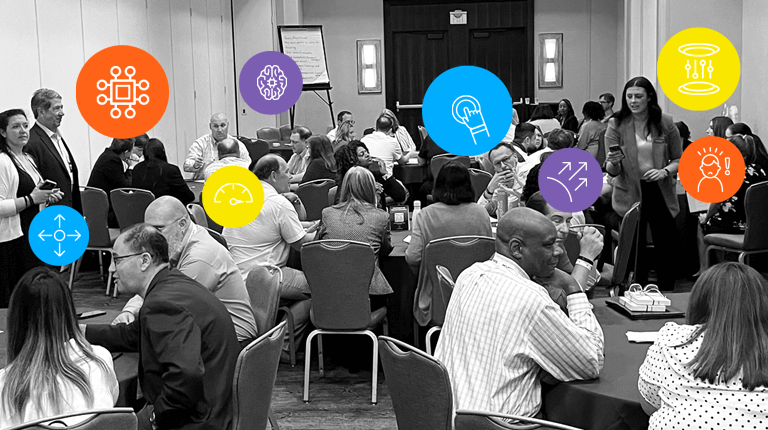As the coronavirus pandemic sweeps the nation and the rest of the world, businesses are forced to make tough decisions. We’ve seen travel bans, the cancellation of public events, and work-from-home mandates. Businesses across industries are trying their best to keep their employees and customers calm, safe, and productive during these testing times.
Emergencies of any nature, from natural calamities to epidemics to global political unrest, force us to rethink the fundamental way of doing business and test the limits of our existing infrastructure and technology. That is exactly what’s happening now.
Let’s consider the travel and hospitality industry, where customer experience is a key competitive differentiator. COVID-19 has impacted both personal and business travel. Countries are banning inbound travel and recommending that people cancel all travel plans. Event managers are canceling and postponing events. Consumers are scrambling to contact airlines and hotels to cancel or change their bookings.
Amidst this chaos with emotions running high, customers still expect these brands to show empathy and offer fast, efficient, and effective solutions. But, brands are struggling to keep their contact centers open and operations running smoothly while ensuring the safety of their employees.
However, even under this high tension, we are seeing some companies thrive at handling customer service transactions, and others fall behind. By simultaneously going back to basics, and using what’s available to think outside-the-box, brands can continue to offer consistent and excellent care even during these challenging times. Based on our experience working with some of the most well-known brands in the world, here are some tips to help reshift businesses focus so companies can continue offering excellent customer service:
Streamlined communication is the key.
Just like with any relationship, direct, clear, and timely communication is the key to maintaining (and even improving) your relationship with customers. Evaluate short-term customer journeys during the crisis with the goal of lowering customer effort and guiding them toward the most relevant information.
If your business is prone to a surge in customer contacts in emergencies, this is especially useful to make answers readily available for frequent queries. Consider the following as part of your new, short-term customer journey:
- Use the findings of a short-term customer journey to create a ‘golden path’ to FAQs
- Create a business continuity plan (BCP) and share it with your customers
- Show your preparedness on a webpage dedicated to the emergency with your company’s actions
- Communicate important updates through a banner message, especially on the channels that see the most volume
Lead with empathy.
Especially in times of need, consumers want brands to show empathy and support. Even if your brand is struggling to keep up with customer service queries, mass policy changes and philanthropic actions can help balance the frustration of individual interactions, such as long wait times. We’re already seeing some companies put their best foot forward by going above and beyond with these broad customer gestures:
- JetBlue became the first airline to waive change and cancel fees for coronavirus-related concerns
- AT&T is suspending broadband data caps from home internet customers to support working and learning from home
- Comcast is raising internet speeds on its Essentials tier designed for low-income families
- Verizon is waiving late fees for customers and small businesses
- Zoom giving K-12 schools free video conferencing tools, extending beyond their traditional customer base to help out
Empathy never goes out of style. In the end, these actions will lead to long-term customer loyalty for the brands that do it right.
Reduce employee effort.
Employee effort directly correlates with customer effort. Contact center employees are typically the first line of defense. If they are stressed or panicked, it can directly translate into customer stress or panic. And during times of high-tension, customer-facing departments such as contact centers feel increased pressure to deliver the same level of, if not better, customer experience. It’s important for contact center management to understand that to reach these high-levels of service for customers, it must start with increasing the efficiency of their own employees. Here are a few recommendations for achieving this:
- Ensure that contact center staff are well equipped with emergency protocols and messaging.
- Provide equipment for employees to work from home, if possible.
- Develop proactive customer communication and appropriate banner messaging to help alleviate the stress on contact center staff.
Preparation over panic.
And lastly, our most important advice is to be prepared, not stressed. As most emergencies are, this pandemic was unpredictable. Companies could not have looked ahead to solve these current problems last year.
However, even during this current situation, companies can strategize how to move forward with the possibility of more intense short-term strains, as well as take note of what should be included for future emergency preparedness. A few key questions to consider are:
- Did this emergency put stress on your workforce? If yes – can you consider a digital or virtual workforce or equip your employees to work remotely?
- Did it test the limits of your infrastructure? If yes – can you move to the cloud or add new technology?
- Did it stress your corporate and customer communications channels? If yes – how can you make them nimble and more widespread?
- Did you have a comprehensive BCP?
Posing and answering questions like this will make sure your business is better prepared for the future.
At Interactions, the safety of our employees, our clients, and their customers is paramount. We also understand the importance of keeping customer satisfaction high during this time, not only to maintain business relationships, but also in an effort to spread positivity in a time of chaos.




